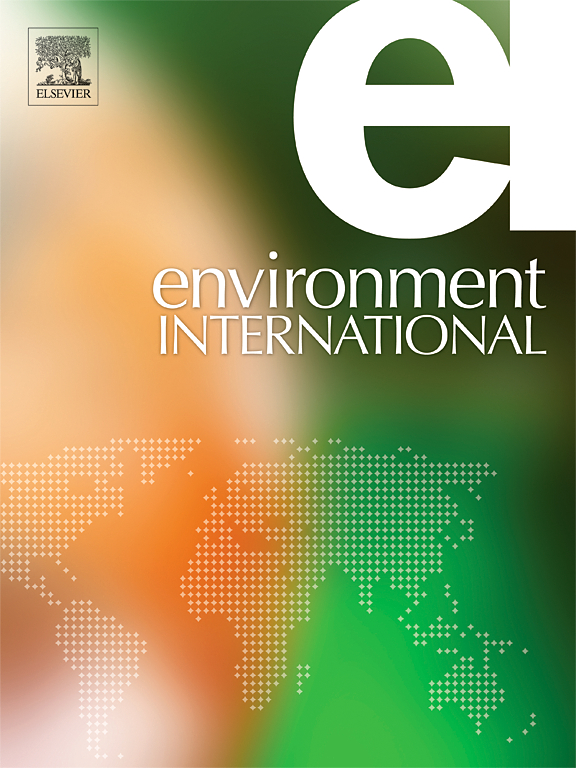Personal care product use and risk of adult-onset asthma: Prospective cohort analyses of U.S. Women from the sister study
IF 9.7
1区 环境科学与生态学
Q1 ENVIRONMENTAL SCIENCES
引用次数: 0
Abstract
Background
Population studies have found associations between prenatal exposure to endocrine-disrupting chemicals (EDCs) in personal care products (PCPs) and childhood asthma; however, few have investigated adult-onset asthma. We investigated the associations between commonly used PCPs and the risk of adult-onset asthma in a prospective cohort study of U.S. women.Methods
We analyzed 39,408 participants from the Sister Study (2003–2009) who self-reported their usage frequency of 41 PCPs in the 12-month period before baseline. In our combined PCP analyses, we used Least Absolute Shrinkage and Selection Operator (LASSO) to select key PCPs that predict the risk of adult-onset asthma. In group-specific analyses, PCPs were aggregated into four product groups (i.e., beauty, everyday hair, hygiene, and skincare products). Subsequently, we conducted latent class analysis to identify groups of individuals with similar patterns of PCP use (e.g., infrequent (reference), moderate, and frequent). Multivariable Cox regression models were used to assess the associations between PCP use and incident adult-onset asthma.Results
Over an average 12.5-year follow-up, 1,774 incident asthma cases were identified. We found a positive association between combined PCP use and adult-onset asthma risk (moderate users, hazard ratio [HR] = 1.19 (95 % confidence interval (CI):1.05,1.33) and frequent users, HR = 1.19 (95 %CI:1.06,1.34)). In group-specific analyses, moderate (HR = 1.21 (95 % CI:1.07,1.37)) and frequent (HR = 1.22 (95 %CI:1.08,1.38)) users of beauty products had a higher asthma risk, compared to infrequent users. Similar associations were observed for hygiene (moderate: HR = 1.14 (95 %CI:1.01,1.29) and frequent: HR = 1.20 (95 %CI:1.06,1.36)) and skincare products (moderate: HR = 1.21 (95 %CI:1.06,1.38) and frequent: HR = 1.20 (95 %CI:1.06,1.35)).Conclusions
Our findings suggest that PCP use potentially contributes to future risk of adult-onset asthma among women.

个人护理产品的使用和成人发作哮喘的风险:来自姐妹研究的美国妇女的前瞻性队列分析
人口研究发现,产前暴露于个人护理产品(pcp)中的内分泌干扰化学物质(EDCs)与儿童哮喘之间存在关联;然而,很少有人研究成人发作的哮喘。我们在一项美国女性前瞻性队列研究中调查了常用pcp与成人发病哮喘风险之间的关系。方法我们分析了来自姐妹研究(2003-2009)的39,408名参与者,他们在基线前的12个月内自我报告了41种pcp的使用频率。在我们的综合PCP分析中,我们使用最小绝对收缩和选择算子(LASSO)来选择预测成人发病哮喘风险的关键PCP。在群体特定分析中,pcp被汇总为四个产品组(即美容、日常美发、卫生和护肤产品)。随后,我们进行了潜在类别分析,以确定具有相似PCP使用模式(例如,不频繁(参考),中度和频繁)的个体群体。采用多变量Cox回归模型评估PCP使用与成人发作哮喘之间的关系。结果在12.5年的随访中,共发现1774例哮喘病例。我们发现联合使用PCP与成人发病哮喘风险呈正相关(中度使用者,危险比[HR] = 1.19(95 %可信区间(CI):1.05,1.33),频繁使用者,HR = 1.19(95 %CI:1.06,1.34))。在群体特异性分析中,中度(HR = 1.21(95 %CI: 1.07,1.37))和频繁(HR = 1.22(95 %CI:1.08,1.38))美容产品使用者比不频繁使用者有更高的哮喘风险。类似的协会观察卫生(温和:人力资源 = 1.14(95 % CI: 1.01, 1.29)和频繁:人力资源 = 1.20(95 % CI: 1.06、1.36))和护肤品(温和:人力资源 = 1.21(95 % CI: 1.06, 1.38)和频繁:人力资源 = 1.20(95 % CI: 1.06、1.35))。结论:我们的研究结果表明,PCP的使用可能会增加女性成人发作哮喘的风险。
本文章由计算机程序翻译,如有差异,请以英文原文为准。
求助全文
约1分钟内获得全文
求助全文
来源期刊

Environment International
环境科学-环境科学
CiteScore
21.90
自引率
3.40%
发文量
734
审稿时长
2.8 months
期刊介绍:
Environmental Health publishes manuscripts focusing on critical aspects of environmental and occupational medicine, including studies in toxicology and epidemiology, to illuminate the human health implications of exposure to environmental hazards. The journal adopts an open-access model and practices open peer review.
It caters to scientists and practitioners across all environmental science domains, directly or indirectly impacting human health and well-being. With a commitment to enhancing the prevention of environmentally-related health risks, Environmental Health serves as a public health journal for the community and scientists engaged in matters of public health significance concerning the environment.
 求助内容:
求助内容: 应助结果提醒方式:
应助结果提醒方式:


